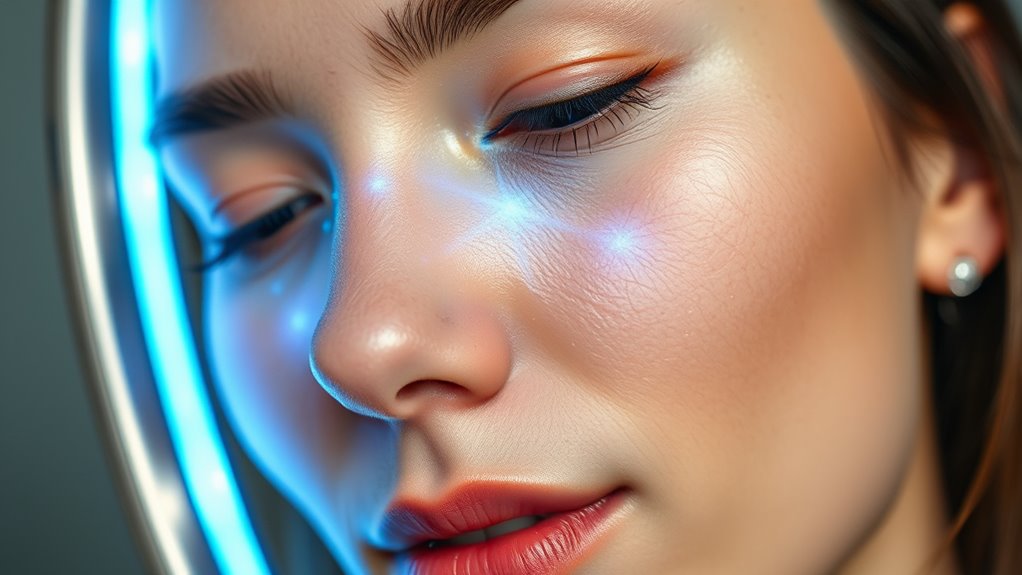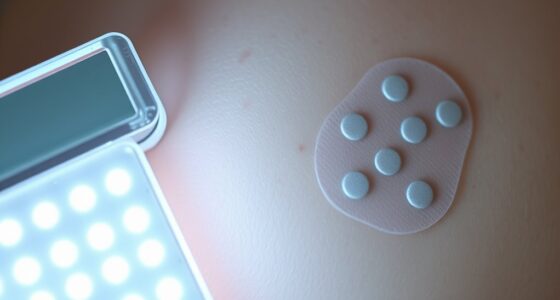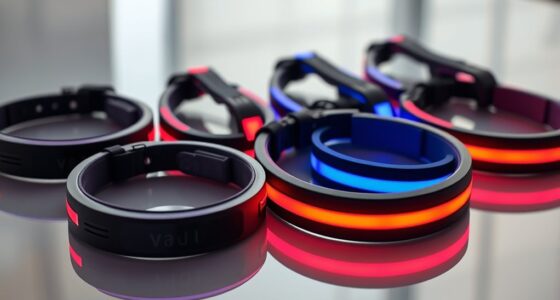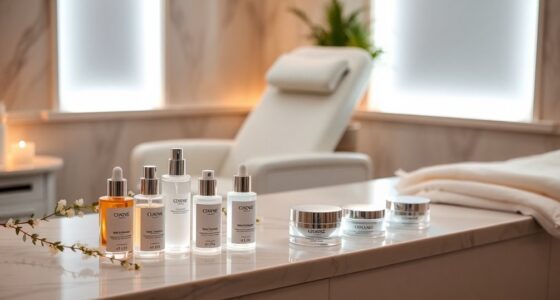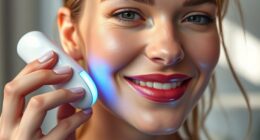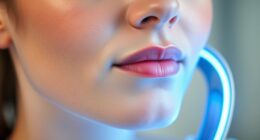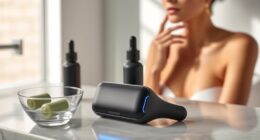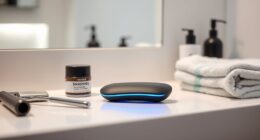LED therapy is a safe, non-invasive way to control excess oil and reduce shine on oily skin. It uses specific light wavelengths to target bacteria, lessen inflammation, and promote healing from within. Regular sessions can help improve skin texture, tighten pores, and boost collagen, leading to a more balanced complexion. If you want to learn more about how LED treatment can help you manage oiliness effectively, keep exploring the options available.
Key Takeaways
- LED therapy uses blue light to target acne-causing bacteria and regulate excess oil production, reducing shine effectively.
- Regular LED treatments promote collagen growth, improving skin texture and minimizing enlarged pores associated with oily skin.
- Non-invasive and painless, LED therapy provides a gentle, safe option to control oil without harsh medications.
- Consistent sessions, combined with proper skincare, enhance oil regulation and help maintain a matte, balanced complexion.
- Consulting skincare professionals ensures personalized treatment plans for optimal shine reduction and skin health.

Are you looking for a safe, non-invasive way to control oily skin and reduce breakouts? LED therapy might be just what you need. This innovative treatment uses specific wavelengths of light to target the root causes of excess oil production, inflammation, and acne. Unlike harsh medications or invasive procedures, LED therapy is gentle, painless, and suitable for most skin types. It works by penetrating the skin at different depths, stimulating cellular activity and promoting healing from within.
Discover gentle, effective LED therapy to control oily skin and reduce breakouts naturally.
When you opt for LED therapy for oily skin, you’re harnessing the power of light to regulate sebum production. Excess sebum is a major contributor to oily skin and breakouts, and traditional treatments often rely on topical products or oral medications that can have side effects. LED therapy offers a natural alternative, encouraging your skin’s own healing processes. The blue light, in particular, is well-known for its antibacterial properties. It helps kill acne-causing bacteria on the skin’s surface, reducing the likelihood of future breakouts. Additionally, it can diminish inflammation and redness associated with acne lesions, leaving your skin clearer and calmer.
Another significant benefit of LED therapy is that it can improve skin texture and reduce the appearance of enlarged pores, which are common in oily skin. When you receive regular treatments, you may notice your skin feeling smoother and looking more refined. This is because the therapy encourages collagen production, helping your skin regain firmness and elasticity. Collagen is essential for maintaining a youthful appearance and can also help minimize the size of pores, giving your face a more balanced look.
The process itself is straightforward and convenient. During an LED session, you sit comfortably while the therapist or device directs light over your face. The treatment typically lasts between 15 to 30 minutes, and you can usually resume your daily activities immediately afterward. Most people experience no discomfort—some even find it relaxing. To see noticeable improvements, a series of treatments is often recommended, usually spaced a few days apart. Over time, you’ll likely notice your skin becoming less oily, clearer, and more resilient.
While LED therapy offers promising results, it’s important to remember that individual responses vary. Maintaining a consistent skincare routine, staying hydrated, and avoiding overly harsh products will support your treatment’s effectiveness. Always consult a skincare professional to determine if LED therapy is suitable for your specific skin concerns. When used correctly, it’s a safe, effective way to manage oily skin and achieve a healthier, more balanced complexion without the risks associated with more aggressive treatments.
Additionally, understanding the tax implications of various skincare treatments can help you make more informed decisions about your skincare investments and routine.
Frequently Asked Questions
Can LED Therapy Cause Skin Dryness or Irritation?
Yes, LED therapy can cause skin dryness or irritation, especially if you have sensitive skin or use the wrong settings. You might notice redness, dryness, or mild discomfort after treatment. To minimize these effects, follow your practitioner’s instructions carefully, keep your skin moisturized, and avoid harsh products. If irritation persists or worsens, consult your dermatologist to adjust your treatment plan or explore alternative options.
How Often Should I Use LED Treatments for Oily Skin?
Think of it like tuning a vintage radio—balance is key. You should use LED treatments for oily skin about 2-3 times a week, especially when starting out. This frequency helps reduce excess shine without overdoing it, which could cause dryness or irritation. As your skin responds, you can adjust the sessions. Always follow your dermatologist’s advice and monitor your skin’s reactions, just like you’d tweak a classic record for perfect sound.
Are There Any Side Effects of LED Therapy on Oily Skin?
Yes, LED therapy can cause side effects, but they’re usually mild. You might experience temporary redness, dryness, or slight itching after treatment. Some people notice sensitivity or a tingling sensation, but these effects typically fade quickly. To minimize risks, follow your practitioner’s instructions and avoid excessive exposure. If you notice prolonged discomfort or unusual reactions, consult your dermatologist to guarantee LED therapy is safe and suitable for your oily skin.
Does LED Work on All Skin Types With Oiliness?
Yes, LED therapy works on all skin types with oiliness, but results can vary. You might notice improved oil control and reduced shine, especially with consistent sessions. However, your skin’s unique response depends on factors like sensitivity and severity of oiliness. It’s best to consult a skincare professional to customize the treatment for ideal results, ensuring it’s safe and effective for your specific skin type.
Can LED Reduce the Size of Enlarged Pores?
Yes, LED therapy can help reduce the appearance of enlarged pores. It stimulates collagen production, which tightens the skin and makes pores look smaller. You’ll notice improvements over time with regular treatments. To get the best results, follow your dermatologist’s advice and maintain a consistent skincare routine. Keep in mind that individual responses vary, so patience and persistence are key to achieving smoother, more refined skin.
Conclusion
Just like a guiding lighthouse cuts through the fog, LED therapy shines a light on your oily skin, helping you reduce shine and regain confidence. Embrace this modern marvel as your secret weapon, illuminating your path to clearer, matte skin. Remember, with patience and consistency, you’ll navigate away from excess oil and toward smooth, radiant results. Let LED be your gentle reminder that, even in darkness, hope and clarity are within your reach.
